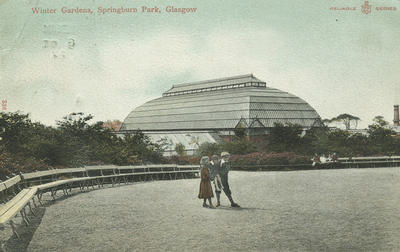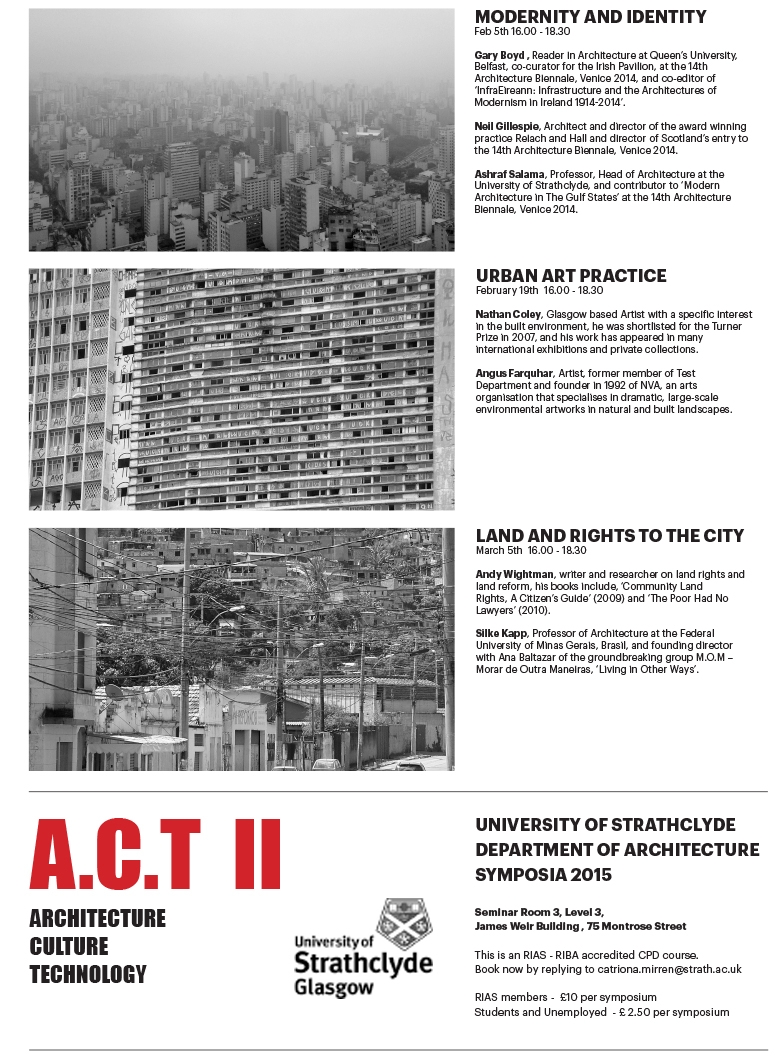Yasmin Ali
Urbanism // Design
Preview: SHBT Lecture series 2023
March 28th, 2023The Scottish Historic Buildings Trust (SHBT) is a charitable organisation focusing on historic and heritage architecture, and is the largest organisation of its kind in Scotland. They have saved and enabled the restoration of twenty-five significant Scottish buildings, including its base at Riddle’s Court, off the Royal Mile, also known as The Patrick Geddes Centre, where they hold their events and lecture series. They have recently announced on their social media channels, their Spring Lecture series, which includes two speakers a month, featuring aspects of local architectural and urban social history.
The talks are available for in-person and online viewing and feature a range of knowledgeable speakers, including professors and historians. The Spring series of six lectures mostly focuses on the rich history of The Tron Kirk, sited on The Royal Mile, a few minutes walk from Riddle's Court. Some of the talks also include a walk to the nearby Tron and its surroundings, including the upcoming walk and talk led by John Lowrey: 'Puddings, Printing and Palladianism: The Tron in its Context' on 26th April. It is sure to be an interesting way to spend a Springtime evening.
Event Preview: ACT Symposia Spring 2015
January 20th, 2015
ARCHITECTURE CULTURE TECHNOLOGY Symposia Series
Strathclyde's Architecture school has announced their ACT programme for 2015, which builds on the success of last year's sessions. Award-winning artists, academics, artists, architects and writers have been invited for a carefully curated curriculum of Architecture, Culture and Technology seminars.
Current themes are:
- Modernity and Identity
- Urban Art Practice
- Land and Rights to The City
The series begins on the 5th of February with Modernity and Identity. Speakers on this theme include Gary Boyd, Reader in Architecture at Queen’s University, Neil Gillespie, Architect and director of Reiach and Hall and Ashraf Salama, Professor, Head of Architecture at the University of Strathclyde. All three esteemed speakers also have a connection to the Venice Biennale Architecture programme 2014.
Each session takes place on a Thursday evening, from 1600-1830. The symposia are open to all. For professional architects this is an RIAS-RIBA accredited CPD course.
Dates for sessions:
Modernity & Identity 5th February;Urban Art Practice 19th February;Land Rights to the City 5th March
Times: 1600-1830 for all sessions
Venue: University of Strathclyde, Department of Architecture, 75 Montrose Street
RIAS members - £10 per symposium; Students and unemployed - £2.50
For more information and to book please reply to catriona.mirren@strath.ac.uk
// Reviews to follow
Entries in: Springburn Winter Gardens Competition
September 21st, 2014
Restore Springburn Winter Gardens is a passionate and informed community-led project by Springburn Winter Gardens Trust to restore Scotland's largest glasshouse, the 'A-listed' Springburn Park Winter Gardens, for future generations of Glaswegians. It has been backed by an architectural competition for a pavilion to be constructed in the interim phases of the project during restoration.
The competition, run by GIA Glasgow Institute of Architects in association with NG Homes and MAKLAB, has attracted a range of competition entries, whose 3D printed models and images are currently on show. To coincide with Doors Open Days, the top 25 are facing a design competition public vote is on at Mosesfield House today from 11am till 5pm.
Event Review: How Near is Here? Locality Programme, Collective
September 20th, 2014

'How Near is Here?' Intensive Programme / Tuesday 9 - Friday 12 September
| Collective |
| Session Review | Thursday 10am - 1pm
Last Thursday, I attended part of a intensive programme of talks, walks, workshops and discussions at Collective, centred around themes of Locality and consquent roles of public art and urban interventions within a given locale or local context. Key questions posed included:‘What constitutes the local now?’ and ‘What role does art (and culture) play in constructing a locality?’
The intensive programme and its symposium were titled 'How Near is Here?' and formed Collective Gallery's Summer School with attendees largely ECA Art graduates and professionals engaged in contemporary art practice and academia or community arts.
The workshop I attended was led by artist collective Eastern Surf, who presented an interesting series of work from their portfolio, including novel self-initiated projects such as The Meta Model, a 3D virtual model which brings together areas of work from disparate locations. It also exists as a 3D animated walkthrough and a physical architectural model. They explore similar themes in their in-situ work, Quartermile Render Ghosts. This satirical work saw the photography of people in poses similar to those in architectural visuals, walking through the housing development, posing questions as to the nature of architectural representation, public/private interfaces, and issues of surveillance and CCTV. This set the tone for the interactive workshop in which we produced paper and painted versions of rendered masks, emulating the style of facial detection and recognition software. We also explored the themes and ethos of identity camouflage which is a growing part of this dystopic vision of the future, with software currently piloted around the world, including America and New Zealand.

Above: Eastern Surf's Meta Model
Emma Balkind, PhD Candidate at Glasgow School of Art, was the respondent to this session, and presented a series of ideas around recent urban interventions, including the failed Aberdeen City Garden project, which was blocked by a private developer. Referencing sources as disparate as Hannah Arendt and Law on Common Lands, Balkind explore dialectics of Urban Vs Rural; Feudalism/Capitalism; Public/Private; The Common and The Enclosure, and The Virtual Vs The Physical. Her discussion also touched on aspects of inhabitation, land amenity and The Human Condition.
The settings provided food for thought; the gallery is part of The City Observatory on top of Calton Hill, having moved from its Old Town location over a year ago. With idyllic panoramic views of the city, as well as provocative changing exhibitions, the venue is well worth a visit.
// With Thanks to Collective
Event Review: Beyond Borders Festival 2014, 23rd/24th August 2014
August 27th, 2014

This year I attended Beyond Borders International Festival of Literature and Thought, which has been running since 2010, previously known as Borders, Books and Bikes. The programme was packed with cycle tours, guided walks, author’s talks and political debates and discussions. A central theme has always been Peace and Conflict, and contested territories were discussed in several forums. The event is held in the grounds and within Traquair House, Scotland’s oldest continually inhabited house, a picturesque stately home near Peebles.
I was lucky to sit in on a dialogue with war photographer Paul Conroy’s lunchtime talk subtitled ‘Seeking Sanctuary’ about his British Red Cross exhibition of the same name. Here Paul described his photographic portraiture project documenting Syrian refugees seeking asylum in Scotland. Conroy told of the challenges of depicting people without showing their faces, in rooms with no real distinctive features, and the daunting task of portraying character in such surroundings. In Conroy’s words, he described it as more challenging than his war photography overseas. The photographs were also on display in the Exhibition tent and are on tour throughout the UK this year.
The following day, for the first talk we sought sanctuary in the chapel at Traquair House for a discussion with Feeding Frenzy author Paul McMahon, about the politics of food in the 21st century. McMahon was joined by Delfina Foundation director and Director of Visual Arts of Beyond Borders Scotland, Aaron Cezar, who presented slides of recent artwork on food politics from the Delfina Foundation for hungry eyes. Lawyer, author and academic Oscar Guardiola-Rivera led the discussion; and also chaired The Rule of Law discussion, which is an event common to many previous Beyond Borders’ Festivals. Sir Jeffrey Jowell QC of the Bingham Centre for the Rule of Law, the UN’s Andrew Gilmour, and David Marshall were on the panel to discuss what the rule of law means for today’s international policymakers, and how to sensitively – and modestly – intervene in international relations.
I found most provocative the discussion ‘Lifting the veil’, in particular, details of journalist and Iranian correspondent Ramita Navai’s book Tehran: City of Lies, which exposes details of contemporary urban life in Iran, including double-standards and deceptive appearances within society. Navai was able to infiltrate areas of Tehran invisible to many of its citizens and tell surprising stories which have been woven into narrative fiction. Also present was author and columnist Yasmin Alibhai-Brown positing the counter question regards the danger of Muslim women in the West reassuming the veil. The discussion was chaired and led by author Bonnie Greer OBE.
Beyond Borders events continue with its film festival in Edinburgh this week, and more events planned for 2015. For details of future events go to the website here.
// With Thanks to the Beyond Borders Team based in Edinburgh




